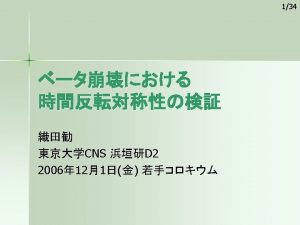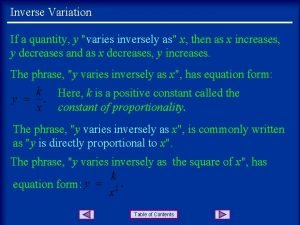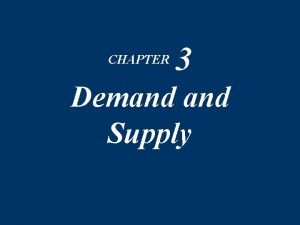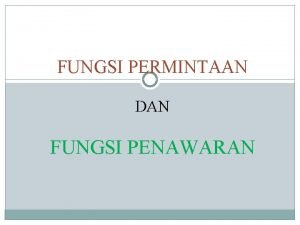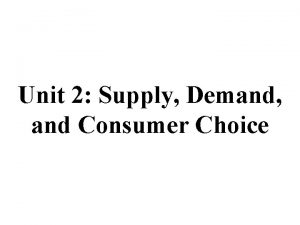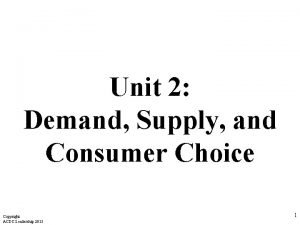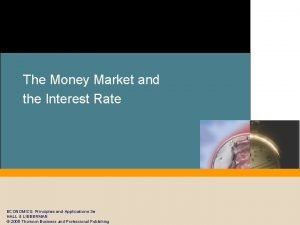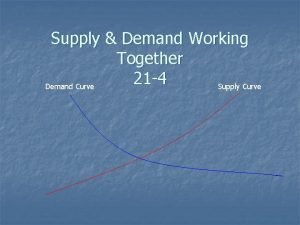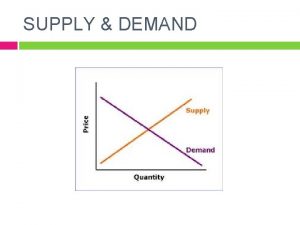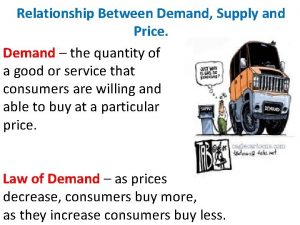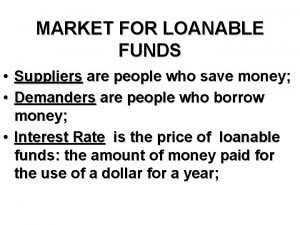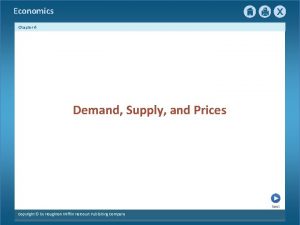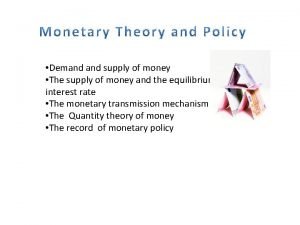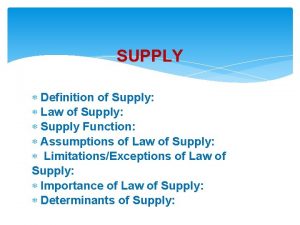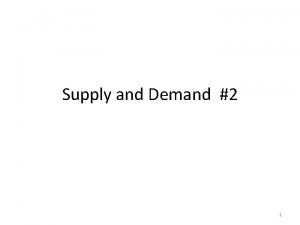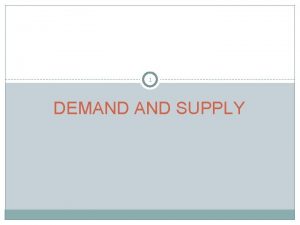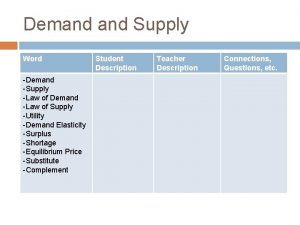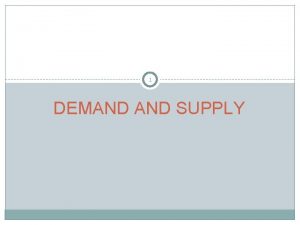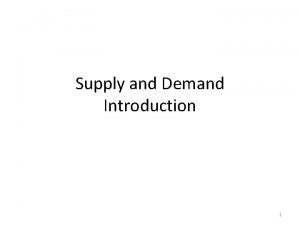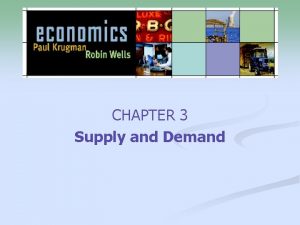Supply and Demand II Demand A Definition Quantity




























- Slides: 28

Supply and Demand

II. Demand A. Definition Quantity demanded: the amount of a good that households want to consume given their income and prices in a given time period.

B. Demand Schedule: shows the relationship between the price level and the quantity demanded. Price: Monthly rent per apartment $500 Quantity: Apartments per month 400, 000 $450 475, 000 $400 550, 000 $350 625, 000 $300 700, 000 $250 775, 000 $200 850, 000

C. The Demand Curve Price $500 $450 $400 $350 $300 $250 $200 D 4 4. 5 5 5. 5 6 6. 5 7 7. 5 8 8. 5 Quantity

n LAW OF DEMAND As the price of a good increases, the quantity demanded falls, (ceteris paribus) n Ceteris Paribus - holding all else constant

Why is the demand curve downward sloping? - Law of diminishing marginal benefit: As more units of a good are consumed, additional units provide less benefit. - Substitution effect: The change in the quantity demanded of a good that results from a change in price making the good more or less expensive relative to other goods that are substitutes - Income effect: The change in the quantity demanded of a good that results from the effect of a change in the good’s price on consumer purchasing power.

SUPPLY - thinking like the producer n A. Quantity Supplied - the amount of a commodity that a firm plans to sell in a given time period at a given price. n B. The law of supply - as the price for which a good can be sold increases, the quantity of that good that is supplied will increase, ceteris paribus n

Supply Schedule: shows the relationship between the price level and the quantity supplied. Price: Monthly rent per Quantity: Apartments apartment per month $500 700, 000 $450 625, 000 $400 550, 000 $350 475, 000 $300 400, 000 $250 325, 000 $200 250, 000

The Supply Curve Price $500 $450 $400 $350 $300 $250 $200 S 2 2. 5 3 3. 5 4 4. 5 5 5. 5 6 6. 5 Quantity

Market Equilibrium i. Graphically Price S QD=QS PE D QE Quantity

PE and QE are the equilibrium price and quantity. n Equilibrium - in the market is where QS = QD. (No tendency for change) n

Price: Monthly rent per apartment QD Apartments per month QS Apartments per month $500 400, 000 700, 000 $450 475, 000 625, 000 $400 550, 000 $350 625, 000 475, 000 $300 700, 000 400, 000 $250 775, 000 325, 000 $200 850, 000 250, 000 WHERE IS EQUILIBRIUM IN THIS MARKET? At $400, QD=QS= 550, 000 PE = $400 QE = 550, 000

iii) Algebraically n n n n n Demand Curve: QD = 14 - 2 P Supply Curve: QS = 4 + 3 P at equilibrium QD = QS Or 14 - 2 P = 4 + 3 P Solve for PE 14 = 4 + 5 P 10 = 5 P 10/5 = PE = $2 QE = 4 + 3(2) = 10

Disequilibrium in the Market, Excess Supply P P* PE Surplus or excess supply a QD at P* S c QS at P* n n b n D n n n QE Q n At P*, QS > QD Excess supply puts downward pressure on the price. i. e. producers having sales As the price falls, QD rises (a to b, law of demand) and QS falls (c to b, law of supply) to bring the market to equilibrium.

Disequilibrium in the Market, Excess Demand S P n n b PE n QS at P* * P a c QD at P* Shortage or excess demand QE D Q n n At P*, QD > QS Excess demand puts upward pressure on the price. As the price rises, QD falls (a to b, law of demand) and QS rises (c to b, law of supply) to bring the market to equilibrium.

Changes in QD and Demand graph (1) (movement along D due to change in price) Price $4. 00 If the price falls, quantity demand rises A B 2. 00 D 40, 000 60, 000 Quantity

A Shift of The Demand Curve graph Price per unit of x At each price, more units of X are demanded after the shift B $2. 00 D 3 40, 000 60, 000 C D 1 80, 000 D 2 Quantity of X

Things that Shift the Demand Curve Income n Price of related goods n Changes in tastes n Changes in population n Expected future prices n

Remember: A change in price will imply a movement along the curve (we call this a “change in quantity demanded”) n A change in anything else besides the price will shift the curve (we call this a “change in demand”) n

VII. Shifting the Demand Curve Change in the price of a related good: Substitutes Surplus So P PEo PE 1 a QD at PEo c QS at PEo b Do D 1 QEo Q Think about the mkt for tacos. What happens if the price of burritos where to fall? n Shift in Dem, movement along the curve for supply n Change in demand Change in quantity supplied n

Shifts in Demand n What will happen in the mkt for cameras if memory chips get cheaper?

n So P b PE 1 PEo QS at PEo c a Shortage Do QE 1 QD at PEo D 1 Q n Increase in demand Increase in quantity supplied

Changes in Income – Normal and Inferior Goods So P PE 1 n n PEo Do QE 1 D 1 Q n The market for houses when income rises Houses are normal goods Movement along S is an increase in “quantity supplied”

So P n a PEo PE 1 B)ii) Inferior Goods b Do D 1 QEo Q n n The market for low cost rental housing when income rises Inferior good Movement from a to b is a change in QS

Changes in Quantity Supplied Price S Price increase moves us rightward along supply curve P 2 P 1 Price decrease moves us leftward along supply curve P 3 Q 1 Q 2 Quantity

Graph (2): Changes in Supply Price S 3 S 1 S 2 Quantity

Things that shift the supply curve n Price of inputs ¨ As n input P ↑, S shifts to the left Technological changes ¨ As tech increases making it easier/cheaper to produce a good, S shifts to the right n Number of firms in the mkt ¨ As n # of firms ↑, S shifts to the right Expected future prices ¨ As expected future prices ↑, S shifts to left

Examples: Illustrate what would happen using our S/D model n n n 1) Consider the mkt for Univ. of Alabama sweatshirts: Alabama wins the national championship. 2) Consider the mkt for orange juice: A late frost harms orange trees driving up the cost of oranges. 3) Consider the mkt for computer memory: Windows 7 is released and requires more memory than previous editions. 4) Consider the mkt for yards of polyester fabric: Polyester leisure suits fall out of fashion. 5) Consider the mkt for unskilled labor: Immigration laws are loosened that allow a large influx of unskilled workers into the US. 6) Consider the mkt for tomatoes: Wages for unskilled agriculture workers have fallen.
 Module 5 supply and demand introduction and demand
Module 5 supply and demand introduction and demand Matching supply with demand
Matching supply with demand Vector and scalar quantity
Vector and scalar quantity Scalar quantity and vector quantity
Scalar quantity and vector quantity Scalar quantity and vector quantity
Scalar quantity and vector quantity Scalar quantity
Scalar quantity Quantity y varies inversely as quantity x
Quantity y varies inversely as quantity x Decrease in supply vs decrease in quantity supplied
Decrease in supply vs decrease in quantity supplied Change in supply and change in quantity supplied
Change in supply and change in quantity supplied Quantity supplied vs supply
Quantity supplied vs supply Quantity supplied vs supply
Quantity supplied vs supply Rumus penawaran
Rumus penawaran Chapter 5 section 1 supply
Chapter 5 section 1 supply Unit 2 demand supply and consumer choice
Unit 2 demand supply and consumer choice Acdc copyright
Acdc copyright Copyright
Copyright Money market equilibrium
Money market equilibrium Combining supply and demand worksheet
Combining supply and demand worksheet Interaction of demand and supply
Interaction of demand and supply Combining supply and demand worksheet
Combining supply and demand worksheet Supply and demand of loanable funds
Supply and demand of loanable funds Shifters of loanable funds graph
Shifters of loanable funds graph Supply and demand economics project
Supply and demand economics project Chapter 6 section 1 price supply and demand together
Chapter 6 section 1 price supply and demand together Money supply curve
Money supply curve Supply demand rule
Supply demand rule Aggregate supply shocks
Aggregate supply shocks Shift in sras curve
Shift in sras curve Aggregate demand supply graph
Aggregate demand supply graph





